You know what sounds better than braving the New York restaurant scene on Valentine’s Day? Staying in and eating comfort food. And yes, I know that sometimes means nachos or fries or pizza, but with the crazy January we’ve had here in the U.S., I’ve been craving something a bit more nourishing.
After all, Valentine’s Day is about taking time out to appreciate those you love and giving them a little extra care and attention. That could be friends, a partner/partners, or even yourself. So in my book, cooking a nourishing (and incredibly tasty) meal is a great way to celebrate. And if you want to break out the ice-cream or alcohol later in the night, I won’t judge.
This stew will make your apartment smell insanely amazing. First, we fry some tofu with chives and ginger (a meal in itself!), then it gets simmered with kabocha, tamari, thyme, and cumin. Finally, we fold in some kale, add some more seasoning, and pop in some kabocha chunks to bite into (the first ones become part of the stewy sauce!). The result is a velvety, umami-laden sauce with a nice gingery punch, chunks of nutty kabocha and meaty tofu sprinkled throughout, and beautiful, tender greens to add to the love. Serve it with your favorite grain, or enjoy it on its own.
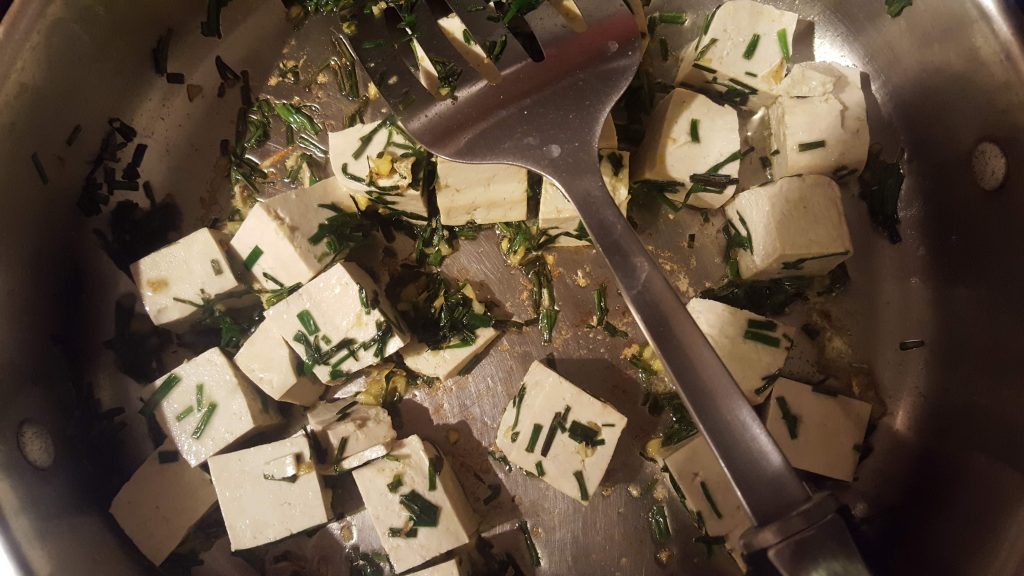
A couple notes about the recipe:
-This recipe is easily customizable. I love the thyme/cumin combo (and highly recommend trying it at least once this way), but you could change the flavor profile altogether by switching up the spices. Or, if you want to spice things up, try adding in some hot paprika/cayenne!
-The super-firm tofu is a must, as it provides some great chew and a meaty texture which is so complimentary to the velvety kabocha. Buy the firmest tofu you can find; I use Trader Joe’s high-protein super-firm tofu, pictured below. If you can only find the kind the comes in the plastic tub, I recommend pressing it. That said, I’m sure the stew will still taste delicious with any tofu; it just won’t be as satisfying texture-wise because everything will be soft.

-Many of the ingredients are added in stages here. We add some of the tamari, but not all of it, add some of the kabocha, but not all of it, add some of the water, but not all of it, etc. You may want to read the full recipe through to get a sense of the whole picture and avoid accidentally dumping everything in at once.
-This recipe is Low FODMAP! In fact, kabocha, chives, and kale can be “eaten freely and according to appetite,” according to the Monash app, as they are basically FODMAP-free. Tofu is safe in 170g servings, which means you wouldn’t come close to exceeding safe serving sizes unless you ate more than 1/3 of the total stew in one sitting :-)
-For some reason, this dish doesn’t hold up very well on the second day. Something about that thyme/cumin combo that makes it SO delicious right after it is made just doesn’t work once everything has sat together for longer. It will also absorb all the liquid and get quite thick, not loosening up all that much after reheating. So my best advice would be to enjoy it on the day it is made, and then use the leftovers to create a separate dish – I tinkered with the spices a bit on the second day, adding cayenne and paprika, then I mixed everything with quinoa and plenty of cheddar cheese and popped it in the oven for a cheesy kabocha bake!
Kabocha & Tofu Stew
- 3 tablespoons neutral-flavored oil (grapeseed, sunflower, etc.)
- 3/4 cup chopped chives (A 1 ounce package)
- 1 tablespoon finely-chopped ginger
- 1 16-oz package super firm tofu (Trader Joe’s brand works well), cut into cubes
- 5 cups chunked kabocha (about 1 medium-large kabocha squash; see chunking directions below)
- 3 ½ packed cups roughly chopped kale leaves
- 3 cups water
- ¼ cup + 1 tablespoon gluten-free tamari
- ½ teaspoon ground turmeric
- 2 teaspoons ground cumin
- 1½ teaspoons dried thyme
- ⅛-¼ teaspoon finely ground black pepper
*To prep the kabocha: Cut it in half lengthwise and scoop out the seeds. Then, cut each half vertically so you have four quarters. Stand each quarter up and slice into thickish horseshoes/arches. Cut around the edges of the horseshoes to remove the peel. Then, cut each horseshoe into chunks.
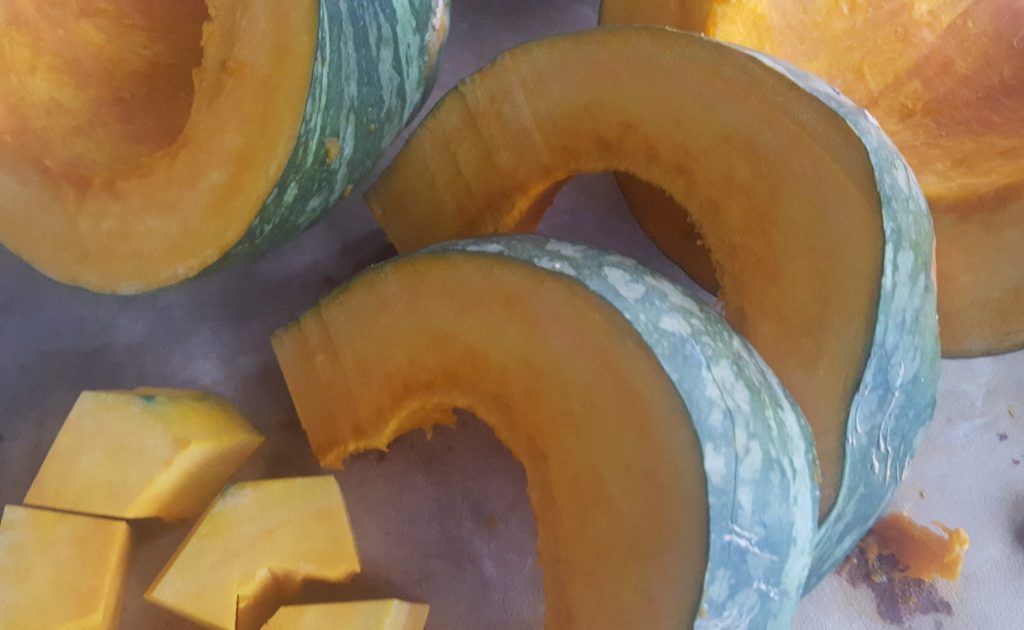
Directions:
Heat the oil in a large, deep skillet, over medium heat. Add the chives and ginger and stir-fry for 2-3 minutes, then add the tofu and stir-fry until you get some nice color and the edges start to crisp, adding 2 tablespoons of the tamari midway through. Use a spatula to help prevent sticking, but it’s okay if it sticks a bit – we’ll fix that in a minute.
Mix together 2 cups of the water, 2 tablespoons of the remaining tamari, the turmeric, 1 teaspoon of the cumin, and 1 teaspoon of the thyme. Add this mixture to the pot (scrape the bottom to take care of any residual stuckness) and add 3 cups of the kabocha. Bring to a boil, then cover, reduce heat, and keep at a generous simmer for about 15 minutes, until the kabocha is tender and easily cutable with a spoon.
Mix the remaining 1 cup water with the remaining 1 tablespoon tamari, 1/2 teaspoon thyme, and 1/2 teaspoon cumin, along with the ground black pepper. Add to the pot along with the kale and the remaining 2 cups of kabocha. Stir in the kale and let it wilt down; then return to a boil. When it reaches a boil, cover and simmer for about 10 minutes. Then uncover, raise the heat again, and let everything cook about 5-8 minutes more, until the first batch of kabocha has become part of the sauce and the stew has thickened a bit (you can help this process along with your cooking spoon). Let cool for a few minutes so you can taste the flavors (it will be VERY hot after all that simmering!). Then taste, adjust seasoning if desired, and enjoy.
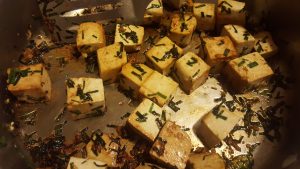

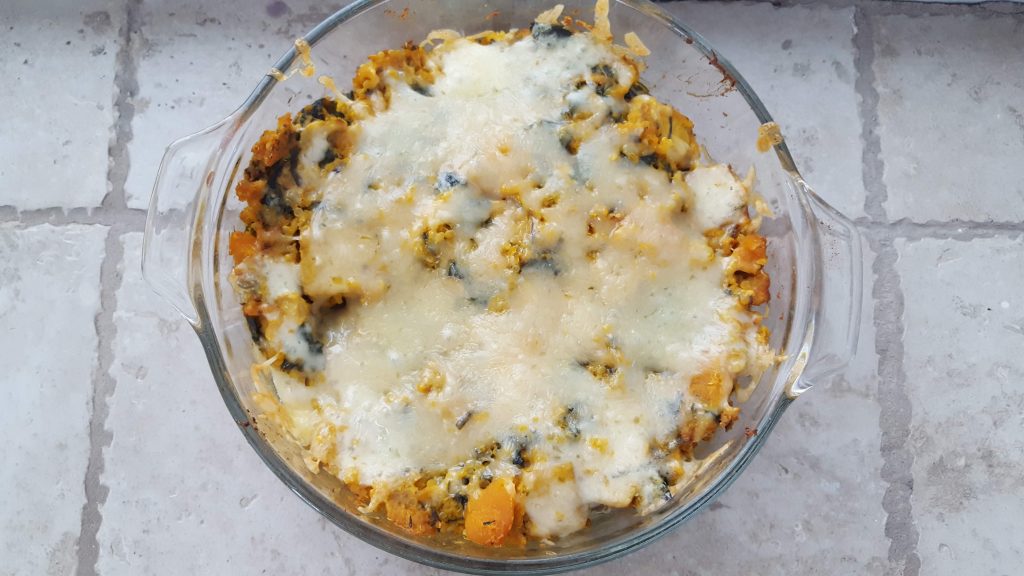
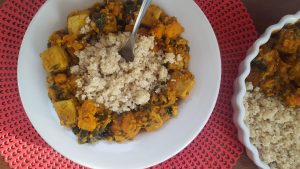
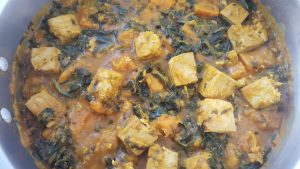

This looks awesome. It’s my favorite kind of winter squash.
Hard to find chives this time of year. Can I use scallions instead.?
Yes, that should work fine!!
Wonderful recipe! I forgot the thyme, so maybe that’ll be a plus after Day 1. Re tofu, we freeze it. defrost, then squeeze out all the liquid – good texture, absorbs seasonings easily,. We usually make similar, African-inspired stews with coconut milk and peanut butter, but this dish is subtler and I don’t miss those ingredients in it. Thanks.